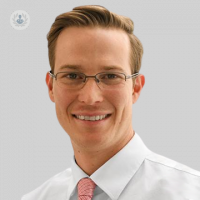Understanding chronic rhinosinusitis with nasal polyps
Escrito por:The sinuses, intricate air-filled spaces within the facial bones, are integral to respiratory health. In his latest online article, Mr Pavol Surda provides insights into their structure, function, and management of conditions like chronic rhinosinusitis with nasal polyps (CRSwNP). Understanding these aspects is crucial for effective diagnosis and treatment, benefiting individuals experiencing sinus-related issues.

What are the sinuses?
The nasal cavity commences at the nostrils and extends backward towards the throat. It is partitioned into left and right sides by the nasal septum. Sinuses, air-filled spaces within the facial bones, connect to the nasal cavity on both sides.
There exist four groups of sinuses on each side: maxillary, frontal, sphenoid, and ethmoid. The maxillary sinuses, large single cavities, occupy most of the space behind the cheekbones. Positioned behind the eyebrows and forehead are the frontal sinuses. The sphenoid sinuses reside at the rear of the nasal cavity, centrally within the skull. Unlike other sinuses, the ethmoid sinuses, situated between the eyes, consist of numerous smaller cells separated by thin bone, resembling a honeycomb. Despite advancements, the exact evolutionary purpose of sinuses remains unclear, and some individuals may lack or have underdeveloped sinuses without encountering issues.
What do sinuses do?
The sinuses are lined with the same tissue as the nasal cavity. Typically, they secrete a small amount of mucus continuously, which drains into the nasal cavity and eventually into the throat, keeping the inhaled air moist and aiding in trapping and combating viruses and bacteria.
In certain conditions, individuals experience chronic inflammation in the sinuses and nasal cavity. Chronic rhinosinusitis, the most common of these conditions, entails inflammation of the entire nasal cavity lining and sinuses, presenting in various forms.
Chronic rhinosinusitis with nasal polyps (CRSwNP) and without nasal polyps are distinguishable types. Nasal polyps, benign inflamed swellings, may necessitate surgical removal when they fill the sinuses and nasal cavity.
CRSwNP, characterised by continuous inflammation and nasal polyp production, is a long-term condition persisting for at least 12 weeks, often extending for years or decades. It necessitates a combination of medical and surgical interventions for management.
How is CRSwNP diagnosed?
CRSwNP patients endure persistent nasal symptoms, including blockage or discharge, for over 12 weeks. Diagnosis involves a nasal examination by an ENT specialist using an endoscope to detect nasal polyps or signs of inflammation.
CT scans of the nose and sinuses may be conducted to confirm the diagnosis and assess the extent of inflammation. Patient-reported outcome measures, such as the SNOT-22 questionnaire, aid in evaluating symptom severity and disease impact on quality of life. Blood tests may be employed for allergy, immune deficiency, or autoimmune disease assessment.
What causes CRSwNP?
Although understanding of chronic rhinosinusitis variants is advancing, the precise triggers for CRSwNP development remain elusive. Various factors likely contribute to long-term sinus inflammation, with bacterial involvement being complex and not solely accountable for the condition's persistence.
Medical treatments for CRSwNP
Management typically entails long-term medication comprising saline nasal irrigation to enhance mucus flow and nasal steroid medication to suppress inflammation. Short courses of oral steroids may be prescribed for severe symptoms. Biologic treatments, targeting inflammatory pathways, offer potential relief for severe cases.
Surgical treatments for CRSwNP
Endoscopic sinus surgery may be considered when medical treatment fails to control symptoms adequately. However, since CRSwNP is chronic, recurrence is common, necessitating ongoing medication and potential surgical intervention.
Mr Pavol Surda is an esteemed adult ENT specialist. You can schedule an appointment with Mr Surda on his Top Doctors profile.


